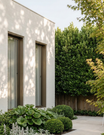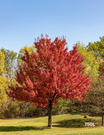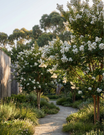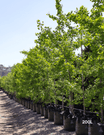Choosing the right tree for your garden can be both rewarding and strategic. One of the most important factors to consider when selecting trees is their growth rate. Whether you're looking for instant impact or have the patience to nurture a slow-growing gem, understanding how fast or slow a tree grows can make a significant difference in the landscape design of your garden.
This guide explores the difference between fast-growing and slow-growing trees, the factors influencing growth rates, and how to choose the right tree for your timeline. Let’s dive in and discover the best options for your high-end garden, starting with three exceptional tree species.
Factors Influencing Tree Growth Rates
Before we examine specific tree species, it's essential to understand what affects a tree's growth rate. Growth rates are influenced by a variety of factors, including:
Soil Quality and Drainage
Good soil quality is paramount to tree growth. Trees planted in rich, well-draining soil grow faster than those planted in compacted or poor soils. Consider amending your garden’s soil with organic matter to ensure proper nutrient levels and drainage for optimal growth.
Water Availability
While some trees are drought-tolerant, others require regular watering to thrive. Adequate water availability during the growing season will significantly impact how fast your tree establishes and matures. For instance, fast-growing species like Fraxinus excelsior need consistent moisture, while slow-growing trees often tolerate drier conditions.
Sunlight Exposure
Trees that receive full sun throughout the day grow much faster than those shaded or partially shaded. Ensure your tree’s planting site allows at least 6 hours of direct sunlight to maximize growth potential.
Tree Species
The most defining factor for growth rate is the species itself. Some species are naturally fast-growing, like Fraxinus excelsior (European Ash), while others, such as Quercus robur (English Oak), are known for their slow, steady development.
Fast-Growing Trees
Fast-growing trees are a great choice if you want to impact your garden immediately. These species can quickly fill space and provide shade, structure, or screening. However, remember that rapid growth can sometimes come at the cost of shorter lifespans or more maintenance.
Fraxinus excelsior (European Ash)
Fraxinus excelsior, commonly known as the European Ash, is one of the most popular fast-growing trees for landscaping. Known for its rapid growth and resilience, this deciduous tree is perfect for adding structure and shade to your garden in a relatively short period.
Key Facts
- Mature Height: 20-30 meters
- Mature Width: 12-20 meters
- Best Uses: Feature tree, shade tree, large gardens
- Leaf Appearance: Pinnate, bright green leaves that turn yellow in autumn
- Rate of Growth: Fast
- Tolerates: Full sun, moist, well-drained soils
Why it's perfect for your garden:
Fraxinus excelsior is ideal if you're looking for a tree that will quickly provide significant shade and visual impact. Its quick growth rate and stately form make it valuable to any large garden or estate. Plant this tree in a prominent spot where it can grow to its full potential and enjoy its beautiful foliage throughout the seasons.
Slow-Growing Trees
While slow-growing trees may require more patience, they often have longer lifespans and a more controlled, elegant growth habit. These trees are perfect for those looking for a statement piece that will mature over decades, becoming a lasting legacy in your garden.
Quercus robur (English Oak)
The Quercus robur, or English Oak, is a classic choice for those who value longevity and tradition in their landscape. This slow-growing tree develops a majestic canopy over time, offering deep shade and a sense of permanence.
Key Facts
- Mature Height: 20-40 meters
- Mature Width: 12-20 meters
- Best Uses: Feature trees, shade trees, parklands, large estates
- Leaf Appearance: Lobed, dark green leaves that turn brown and orange in autumn
- Rate of Growth: Slow
- Tolerates: Full sun, clay, and loamy soils
Why it's perfect for your garden:
Quercus robur is the epitome of a slow-growing, stately tree that provides a lifetime of beauty. Its strong, spreading branches are perfect for creating a sense of grandeur in any garden. Though it takes time to mature, once fully grown, this tree becomes a true focal point and is often considered a symbol of strength and endurance.
Medium-Growing Trees
If you're looking for a middle ground between fast and slow-growing trees, consider those with moderate growth rates. These trees offer a balance of quicker establishment without the risks often associated with very fast-growing species.
Acer platanoides (Norway Maple)
The Acer platanoides, or Norway Maple, strikes a balance between growth speed and longevity. This deciduous tree is well-known for its impressive autumn foliage, making it a standout choice for adding seasonal color to your garden.
H3: Key Facts
- Mature Height: 15-20 meters
- Mature Width: 10-15 meters
- Best Uses: Feature tree, shade tree, urban gardens
- Leaf Appearance: Large, lobed leaves that turn brilliant yellow in autumn
- Rate of Growth: Medium
- Tolerates: Full sun to partial shade, a variety of soil types
Why it's perfect for your garden:
The Acer platanoides is a versatile and reliable option for those looking to enhance their garden with seasonal interest. Its moderate growth rate allows for quicker establishment than other slow-growing trees, yet it still offers the lasting beauty and robustness you’d expect from a high-end garden tree.
Choosing the Right Tree for Your Timeline
Selecting a tree for your garden isn’t just about aesthetics—it’s about understanding your landscape goals and the timeline you’re working with. Here are some final considerations to keep in mind when deciding between fast, medium, and slow-growing trees:
Fast-Growing Trees:
- Provide quick results and shade
- It is ideal for filling gaps or creating an immediate impact
- May require more maintenance (e.g., pruning, pest management)
Slow-Growing Trees:
- Take years or decades to reach maturity
- Offer longevity, durability, and less frequent maintenance
- Best suited for creating a legacy in your garden
Medium-Growing Trees:
- Provide a good balance of growth speed and longevity
- Offer flexibility in both small and large garden spaces
- Typically low-maintenance and adaptable
FAQs
How can I speed up a tree’s growth?
You can promote faster growth by planting in well-draining, nutrient-rich soil, providing regular water, and ensuring the tree gets full sunlight.
Are fast-growing trees weaker than slow-growing trees?
Not necessarily, but fast-growing trees can sometimes have softer wood or be more susceptible to pests and diseases.
How do I choose the right tree for my garden?
Consider your timeline, garden size, and the specific features you want, such as shade, privacy, or decorative appeal.




















































Leave a comment
This site is protected by hCaptcha and the hCaptcha Privacy Policy and Terms of Service apply.